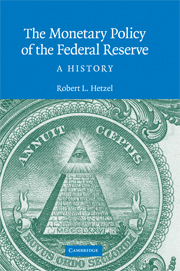Book contents
- Frontmatter
- Contents
- Figures
- Preface
- 1 The Pragmatic Evolution of the Monetary Standard
- 2 Learning and Policy Ambiguity
- 3 From Gold to Fiat Money
- 4 From World War II to the Accord
- 5 Martin and Lean-against-the-Wind
- 6 Inflation Is a Nonmonetary Phenomenon
- 7 The Start of the Great Inflation
- 8 Arthur Burns and Richard Nixon
- 9 Bretton Woods
- 10 Policy in the Ford Administration
- 11 Carter, Burns, and Miller
- 12 The Political Economy of Inflation
- 13 The Volcker Disinflation
- 14 Monetary Policy after the Disinflation
- 15 Greenspan's Move to Price Stability
- 16 International Bailouts and Moral Hazard
- 17 Monetary Policy Becomes Expansionary
- 18 Departing from the Standard Procedures
- 19 Boom and Bust: 1997 to 2001
- 20 Backing Off from Price Stability
- 21 The Volcker–Greenspan Regime
- 22 The Fed: Inflation Fighter or Inflation Creator?
- 23 The Stop–Go Laboratory
- 24 Stop–Go and Interest Rate Inertia
- 25 Monetary Nonneutrality in the Stop–Go Era
- 26 A Century of Monetary Experiments
- Appendix: Data Seen by FOMC for the Stop–Go Period Shown in Figures 24.1, 24.2, and 24.3
- Notes
- Bibliography
- Index
- Titles in the series
21 - The Volcker–Greenspan Regime
Published online by Cambridge University Press: 26 May 2010
- Frontmatter
- Contents
- Figures
- Preface
- 1 The Pragmatic Evolution of the Monetary Standard
- 2 Learning and Policy Ambiguity
- 3 From Gold to Fiat Money
- 4 From World War II to the Accord
- 5 Martin and Lean-against-the-Wind
- 6 Inflation Is a Nonmonetary Phenomenon
- 7 The Start of the Great Inflation
- 8 Arthur Burns and Richard Nixon
- 9 Bretton Woods
- 10 Policy in the Ford Administration
- 11 Carter, Burns, and Miller
- 12 The Political Economy of Inflation
- 13 The Volcker Disinflation
- 14 Monetary Policy after the Disinflation
- 15 Greenspan's Move to Price Stability
- 16 International Bailouts and Moral Hazard
- 17 Monetary Policy Becomes Expansionary
- 18 Departing from the Standard Procedures
- 19 Boom and Bust: 1997 to 2001
- 20 Backing Off from Price Stability
- 21 The Volcker–Greenspan Regime
- 22 The Fed: Inflation Fighter or Inflation Creator?
- 23 The Stop–Go Laboratory
- 24 Stop–Go and Interest Rate Inertia
- 25 Monetary Nonneutrality in the Stop–Go Era
- 26 A Century of Monetary Experiments
- Appendix: Data Seen by FOMC for the Stop–Go Period Shown in Figures 24.1, 24.2, and 24.3
- Notes
- Bibliography
- Index
- Titles in the series
Summary
The lean-against-the-wind (LAW) character of policy whereby the FOMC raises (lowers) the funds rate in a persistent, measured way if the economy grows above (below) trend is the foundation of FOMC procedures. That fact, however, leaves two issues unsettled. First, how does the FOMC impose discipline on these changes to ensure that trend inflation remains unchanged? Second, how much knowledge does it possess about the real economy? Does it possess reliable knowledge of excess capacity or instead the lesser amount of knowledge of how the rate of resource utilization is changing?
The “expected-inflation/growth-gap” label used here to characterize monetary policy in the V–G era suggests the answers supplied in Sections I and II of this chapter. First, although the FOMC abandoned money targets in October 1982, its compass remained the desire to reanchor inflationary expectations unmoored by stop–go monetary policy. The FOMC monitored bond markets as the “canary in the coal mine” for expected inflation. It varied the frequency and magnitude of its routine LAW funds rate changes to the extent necessary to convince the market that those changes would cumulate to whatever extent required to maintain low, stable trend inflation. Second, the routine “housekeeping” funds rate changes that constitute LAW are a measured, persistent response to sustained changes in resource utilization (a growth gap). The Taylor Rule makes the more demanding (and unrealistic) assumption that the FOMC possesses reliable knowledge of excess capacity (an output or unemployment gap).
- Type
- Chapter
- Information
- The Monetary Policy of the Federal ReserveA History, pp. 252 - 271Publisher: Cambridge University PressPrint publication year: 2008
- 3
- Cited by

